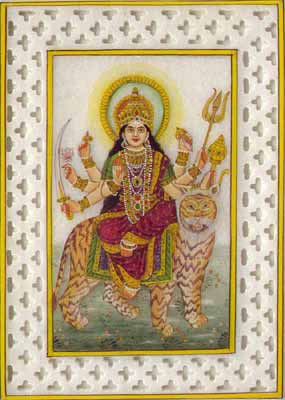
In India a woman with a fiery temperament is often nicknamed Durga in recognition of the divine spark within her. She is the fervent autonomous goddess who knows how to stand for herself.
The living traditions of India have always identified the female of the species with all that is sacred in nature. But it is not always the warrior woman who is identified with the goddess, but also woman as playful, lovable, and of course as the Mother.
In a delightful vein it is conjectured that the kick of a woman is sufficient and necessary for blossoms to spring from the sacred Ashoka tree. An entire ceremony has developed around this theme. Women dance around this tree and gently kick it to bring it to bloom. Ancient Sanskrit poetry describes this happening through the eyes of a jealous lover, who wishes that it were him, rather than the tree which benefited from the touch of her foot:
'She plucked its buds for her ear,
then repaid it with a gentle kick
I might have been the one she struck,
She might have taken the bud from me,
but I'm cheated by a tree!'
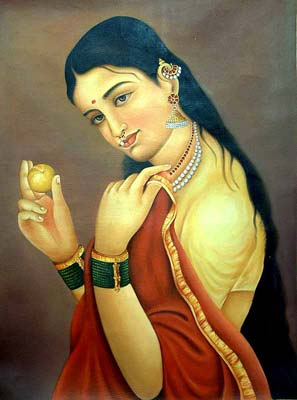 The idea being that by their mere touch, the fertilizing power of a woman was transferred to the tree, which then burst into flowers. All things that arise from the earth in the form of vegetative life mirror the great generative function of the Goddess. The process of transformation that is possible in mortal woman mirrors the miracle of growth that occurs in nature. Such figures emphasize the importance of fertility and its associated elements of bearing and nourishing children. The female figure is an obvious emblem of fertility because of its association with growth, abundance, and prosperity. The idea being that by their mere touch, the fertilizing power of a woman was transferred to the tree, which then burst into flowers. All things that arise from the earth in the form of vegetative life mirror the great generative function of the Goddess. The process of transformation that is possible in mortal woman mirrors the miracle of growth that occurs in nature. Such figures emphasize the importance of fertility and its associated elements of bearing and nourishing children. The female figure is an obvious emblem of fertility because of its association with growth, abundance, and prosperity.
There is also the suggestion that a tree is vulnerable to careless handling like a woman. A tree that has come to flower or fruit will not be cut down; it is treated as a mother, a woman who has given birth. Thus the metaphoric connections between a tree and a woman are many and varied. A relevant one here is that the word for "flowering" and menstruation is the same in Sanskrit. In Sanskrit a menstruating woman is called a 'pushpavati', "a woman in flower". Menstruation itself is a form and a metaphor for a woman' s special creativity. Thus a woman's biological and other kinds of creativity are symbolized by flowering. It is interesting to note here that decoctions made from the bark of the same Ashoka tree are used to soothe menstrual cramps and excessive blood loss during menstruation. The bark decoction also relieves the pain and tension related to menopause.
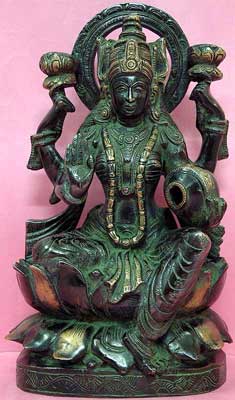 It comes as no surprise that prosperity and abundance too is visualized in the form of a female, namely the Great Goddess Lakshmi. She is often shown holding a pitcher. This pitcher or pot in addition to being likened to a womb, is said to be the pot of bounty, or the harbinger of prosperity. It comes as no surprise that prosperity and abundance too is visualized in the form of a female, namely the Great Goddess Lakshmi. She is often shown holding a pitcher. This pitcher or pot in addition to being likened to a womb, is said to be the pot of bounty, or the harbinger of prosperity.
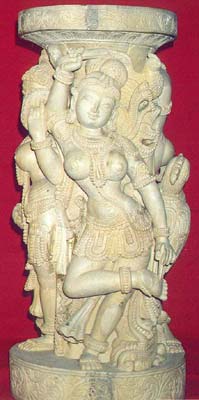 In extension of this conception, Indian aesthetic principles cutting across all schools, sects, and traditions, state in a universal voice that all female forms should be endowed with abundantly full breasts, a narrow waist and ample hips, symbolizing their child bearing capacities and also the power to nourish and sustain their creations, a la Mother Nature. In extension of this conception, Indian aesthetic principles cutting across all schools, sects, and traditions, state in a universal voice that all female forms should be endowed with abundantly full breasts, a narrow waist and ample hips, symbolizing their child bearing capacities and also the power to nourish and sustain their creations, a la Mother Nature.
Indeed Nilakantha Dikshita, an ancient aesthetician, lays stress on the milk of the woman as goddess, sustaining the babies of the earth, her children. He fancies that he pearl necklace on the breast of a goddess creates the illusion of drops of milk dripping and overflowing in fast succession from her moist bosom, in her great and surging affection of motherhood, as she fondles us like babies. This has a parallel to the Great Greek Goddess of fertility, Gaia, the Earth Mother, who is visualized with the mountains as her breasts, the caves her womb, and the earth's waters her female fluids. Thus the body of a woman is nothing but the microcosm of the Earth, embodying in itself all the mysteries of creation, and their solution.
The Buddhist art of India too displays these same symptoms. In the important Buddhist stupa of Bharhut, belonging to around 100 BC, there can be observed an interesting phenomenon. on the railing that encircles the main monument there are numerous sensuous female images. It would be easy to assume that these images were created in order to satisfy the viewing pleasure of male devotees. But a study of the stupa's numerous inscriptions enables us to set aside any such facile assumption. The railing was constructed as a result of community patronage in which the different parts of the railing; pillars, crossbars etc., were donated by various individuals. The inscriptions reveal that many of these sensuous figures were commissioned by women, including Buddhist nuns and monks, often identified by their names. Clearly there was a higher purpose behind the exercise.
The Bharhut stupa was a sacred building built to enshrine a casket that contained a portion of the relics of the Buddha after his cremation. Buddhist pilgrims visited the site to gain proximity to the relics and to experience the unseen presence of the Buddha. Hence it was a ritual space and public domain. Male and female, young and old would have made the pilgrimage and, in the course of repeated ritual circumambulating of the stupa, they would have been exposed to these images. We find, then, that these images were not intended to be viewed as solely sensual objects.
We can thus be fairly certain that the function of such imagery was spiritual, and relevant to the sacred structure to which it belonged. Even then their sensuous portrayal raises questions and requires reiteration of the positive association of woman with fertility, growth, abundance, prosperity and hence, the auspicious. Ancient art texts known as the 'Shilpa Shastras' confirm that the potency of women's fertility and its equation with growth, abundance and prosperity led to women becoming a sign of the auspicious.
In fact, women served an apotropaic function whereby their auspiciousness was magically transferred to the monument upon which they were sculpted or painted. A royal palace, a Buddhist stupa, a Hindu shrine, gained in auspiciousness and fortune when adorned with the figure of a woman. A text of the tenth century, the 'Shilpa Prakasha', that provides guidelines for practicing temples architects and sculptors, categorically states that figures of women are a prerequisite on the walls of temples. Its choice of phrase underscores the significance of the theme. "As a house without a wife, as frolic (play) without a woman, so without (the figure of woman) the monument will be of inferior quality and bear no fruit." Thus by the mere addition of feminine images it was believed that a whole complex could become sacred and auspicious. In fact the same text lists the different types of women who best sanctify a monument, and instructs the sculptor on how to exactly carve these figures. The most important of these feminine images are: - A Woman Dancing
- A Woman Adjusting her Anklets
- A Woman Drummer
- A Mother with her infant in her arms
- A Woman Smelling a Lotus
- A Woman Playing with a Parrot
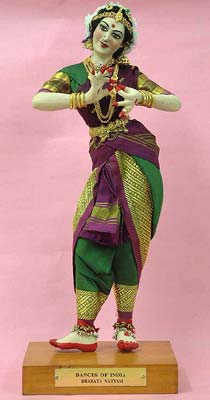
A Woman DancingDance has been defined as a motion that arises from emotion. The human body has a natural appetite for rhythm, and while dancing, not only does the dancer's body vibrate, but by its rhythmic character, also spurs the viewers to a vibrating response. A primitive or a child emotionally aroused, say by some pleasurable observation, will break into a dance of glee. Repeating that particular dance action can recapture the emotion, and thus in dance, motion and emotion are interchangeable. The capacity for such interchange and build-up of feeling is at the root of the identification of dance as a sacred overture.
Dance is an ancient and instinctive expression of the life force, and probably predates drawing and painting as a form of creative activity. It is a form of magic: the dancer becomes amplified into a being endowed with supra-normal powers, and her personality is transformed. Dance is also an act of creation. It brings about a new situation and summons into the dancer a new and higher personality.
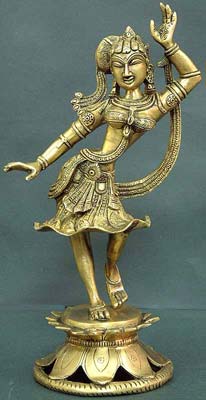 Underlying this celebration of dance is the distinct Indian attitude to the body and the senses. Neither is a temptation nor snare. The relationship of the body, senses, mind, intellect and soul is articulated in the Upanishads and is seminal to the world-view where the body is regarded as the abode of the divine and the divine descends in the body. Underlying this celebration of dance is the distinct Indian attitude to the body and the senses. Neither is a temptation nor snare. The relationship of the body, senses, mind, intellect and soul is articulated in the Upanishads and is seminal to the world-view where the body is regarded as the abode of the divine and the divine descends in the body.
Logically, the body beautiful is the temple of god and dance is a medium of invoking the divine within. Each form of dance - the stance, the movement and the context - is imbued with deep spiritual and symbolic significance. Dance reflects a state of being at the highest order of spiritual discipline (sadhana) and is hence considered a yoga. Its performance is a ritual act, a sacrifice of the personal self to a higher transcendental order. It is the medium which evokes the supreme state of bliss (ananda) and also the vehicle of release (moksha).
The metaphor of dance also lies at the heart of many creation myths. The life force expressed in the act of movement becomes a symbol of creation. Through the medium of dance, a woman embodies the progenitive powers of cosmic energy, through whom, according to an ancient dance treatise 'the entire phenomenal world is kindled into life.'
It does not come as a surprise therefore that in ancient times, a woman dancer was considered an inseparable part of any ritual worship in temples. Every temple of consequence had attached to it one or more dancers. Such women were known as Devadasis. These sacred dancers were symbolically married off to the presiding deity of the temple. Thus an 'ordinary' human woman was found holy enough to be married off to a god, the Lord of the temple. The transformation of an ordinary girl into a Devadasi was marked by important rituals, after the completion of which the woman was considered 'an ever auspicious woman' (nityasumangali). The traditional view holds that all women, by their very nature, share the power of the goddess. The devadasi initiation rites celebrate the merger of her individual female powers with those of the goddess. It is this quality of 'eternal auspiciousness' in a woman that brought into existence this tradition since the earliest times.
The importance of the devadasis can be gauged from the fact that their presence was deemed necessary at the slightest event of importance taking place in the temple, for example bathing the deity in the morning, or waving the sacred fire lamp in front of him. An important ritual was the participation in the twilight worship held at sunset. The 'junction' of twilight, when the day slips into the night, is considered extremely dangerous, and so the gods need all the support and attendance they can get. The ritual waving of the lighted lamp by a devadasi was considered the most effective method of warding off an inauspicious state of the divine. Thus their participation in the affairs of the temple was not restricted to dancing on important religious festivals and events, without which the celebrations were thought of as incomplete, but also managing the day-to-day activities along with the officiating priest. But dance of course remained their most accomplished contribution; indeed the life of a devadasi required a strict adherence to dancing schedules and practice.
Dance is potentially both sensual and hypnotic. Its passioned performance helped to evoke the atmosphere of the temple as a place removed from the mundane world, the temple as a celestial abode of the deity. 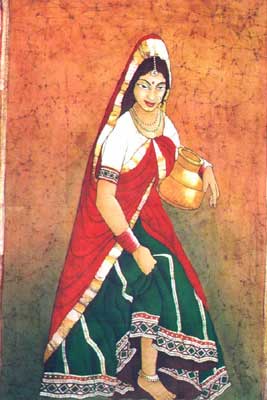
A Woman Adjusting her AnkletsThe Indian tradition thinks of feet as impure. Even then the feet of a woman are worthy of adornment, no less than any other part of her body. In fact the image of a woman adjusting her anklets was considered sacred enough to be carved out in temple walls. A woman has no associated impurity, anything and everything connected with her acquires a status over and above its material existence.
Wearing jewelry and adorning themselves with ornaments comes naturally to a woman. Ancient texts identify sixteen different embellishments (solah-shringar), which acknowledge and celebrate the beauty and divinity of the female form. Sixteen, a significant number, corresponds to the sixteen phases of the moon, which in turn is connected with a woman's menstrual cycle. A woman of sixteen is considered to be at the peak of physical perfection in her life. This is another pointer to the identification of the female with the spiritual. The anklet is mentioned as the last of these sixteen ornaments.
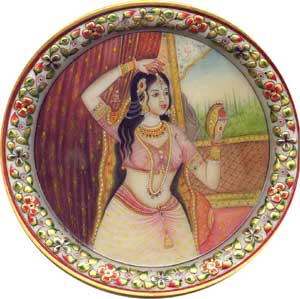
It is not that women do not realize the spiritual potential of ornamentation. By adorning their visible, material body, they also satisfy a universal longing for the embellishment of its intangible counterpart: the human spirit. If this were not so, the desire for ornamentation could not have survived, nay thrived during the continuing course of history.
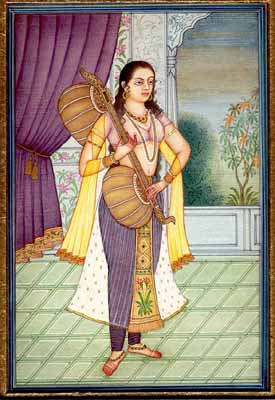 A Woman Drummer A Woman Drummer
In India music was linked with the origin of life itself, where sound is regarded as the primordial vibration of divine energy.
Human mind has resorted to music, the language of symbols, achieving in the process an inner unification of the mind by means of an outer integration of musical principles. Music at the summit of its perfection has striven to symbolize the highest and innermost realities of the mind: a spring of self-expression which eventually flows into the ocean of spiritual experiences. It aspires to be an art guided by knowledge and motivated by inspiration to bring to man a sense of eternity and a state of ecstasy, which is all that he in his mortal frame can taste of immortality. The purpose of music is to enable the mind to comprehend eternity and to enjoy ecstasy. on a practical level, music has a high educational value, it ennobles the mind and awakens and feeds the aesthetic sense.
A lady playing a drum is a representation soaked in symbolism and rich in metaphorical imagery. A drum represents thunder, the voice of cosmic energy. Of all musical instruments, the drum is the most primeval means of communication, its percussive sound traveling to the heart and, by extension, suggesting the ability to communicate with supernatural forces.
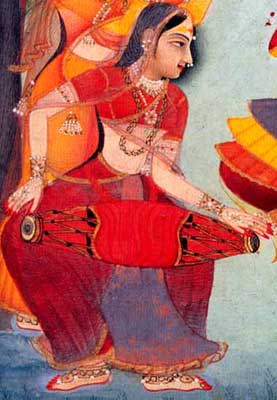 The symbolism of the drum operates at many levels. Firstly there are its materials - wood and hide. The hide being a symbol of regeneration. Since ancient times, the skin of a sacrificial animal, such as the bull or horse, represents the fat of the animal and, by extension, all life-sustaining produce; also progeny. Indeed all qualities associated with the natural functions of a woman. The symbolism of the drum operates at many levels. Firstly there are its materials - wood and hide. The hide being a symbol of regeneration. Since ancient times, the skin of a sacrificial animal, such as the bull or horse, represents the fat of the animal and, by extension, all life-sustaining produce; also progeny. Indeed all qualities associated with the natural functions of a woman.
The wood of the drum is symbolic of a tree itself, which expresses maternal nourishment and support. It is wood that gives shelter at birth as a cradle and in death as the coffin. It is noteworthy here that in China wood is also an emblem of spring, the season of fertility and ripe blossoms.
That the drum is hollow from the inside is also not without spiritual significance. It is a receptive void, to be entered as a woman is, protective, cavernous, a furrow, a shelter and hence a symbol of the womb and therefore birth.
Finally the oval shape of the drum is a symbol of fertility, the feminine creative principle. 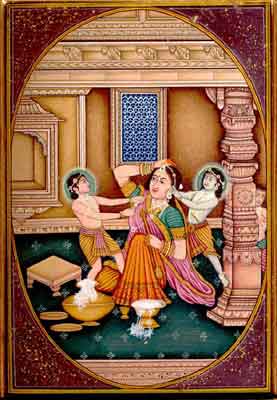
A Mother with Her Infant in Her ArmsA child's first master is always his/her mother, whence the crucial role she plays and the particular regard in which she is held by both child and man. It is not merely that she has given him life, which is often a fortuitous accident, nor only because she has nourished him with her milk, but because she is the one who initiates the child into the society of man and who teaches the first rudiments of language and behavior on which his whole future development depends.
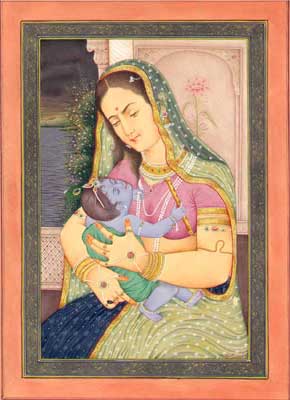
All women have two natures, two distinct characters, as both lover and mother. As lover she represents the strength and creative power of the male principle, which without her is sterile. She is his inspiration, the instrument of his realization, the source of his pleasure. She is the image of Shakti, the power and joy of the gods, who without her would have no existence. It is as mother, however, that woman represents the transcendent aspect of the divine. She is the supreme refuge in which the male plays no role. The goddess mother is the sole source of being, the supreme state of consciousness, the principle of life itself.
Woman is the image of the calm of primordial night for which man yearns, tossed on the waves of life, seeking the state of perfection, the total peace from which he came forth. The universal mother thus appears to man as the supreme state of the divine. All creation, all thought, all form, all existence come from the mysterious energy that appears in the substratum, this matrix of the great goddess, the universal mother, from whom all forms and beings come. 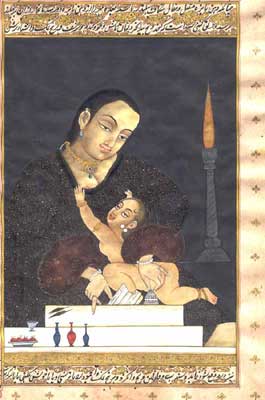
As mother, woman is divine and is worshipped. A mother is bereft of artifice. She is man's comfort, wandering through the deserts of the world. She is forgiveness, charity, and limitless compassion. The woman who realizes the perfection of her maternal role is the very gate of heaven.
The respect and duty owed to this first of all masters and the authority she retains make the mother an essential and symbolic figure throughout life. This is woman's double nature: passive in her relationship with men, active as mother of her children. It is well known, moreover, that the most coquettish and timid woman, when her child is in danger, becomes courageous and enterprising, heedless of her makeup, her weakness, her hair, or the injuries she mighty receive.
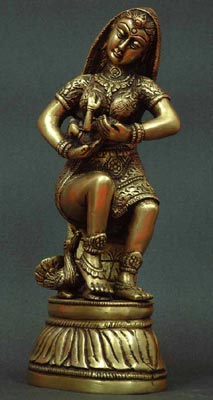
In visual representations, the mother is most often shown suckling her baby. Indeed the grace and sweetness of vegetal life pervade and enliven the lovely bodies of both mother and child. Here fertility and maternity, the grand old themes of the archetypal figures of the mother goddesses are relieved of their ancient abstractness and diagrammatic monumentality, achieving a composition of refined and intimate realism. Brought down to the terrestrial plane from the sphere of ideals, such an image is both contemporary and eternal. 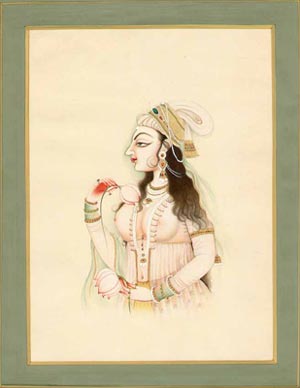 Woman Smelling a Lotus Woman Smelling a Lotus
To the Indian imagination this beautiful flower is associated with divinity. An early medieval text describes the goddess as being:
Slender as the lotus-fiber,
Lotus-eyed,
In the lotus posture,
Pollen dusting her lotus-feet,
She dwells
In the pendant lotus of the heart.
Indian literature classifies women into four types of which the highest is Padmini, the Lotus Lady whose very breath contains the fragrance of the lotus. Because of its entrancing fragrance, the sweet and pervasive freshness of the lotus is captivating. The honey produced in the calyx is so sweet and maddening that it is believed that the bee forgets to get out of it and prefers to remain veiled inside the lotus through the night.
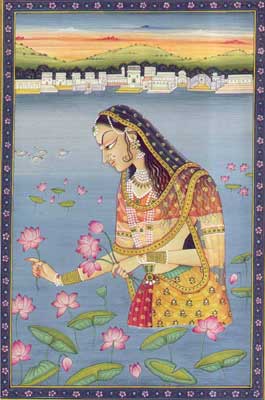
Ancient mythmakers used the lotus as a common symbol of fertility. The plant was native to many areas of the world, so it occurred frequently in myths and was highly revered by people of many cultures, including the Egyptians and the Persians. It is the very behavior of the flower that gives rise to this symbolism.
Sinking to the bottom of the water at night, it rises to the surface in the morning, and spreads its petals on the surface. This awakening and blooming of the lotus at the first rays of the morning sun is a recurrent theme in Indian literature also.
The lotus is the symbol of absolute purity; it grows from the dark watery mire but it is untainted or unstained by it. As the seed of the lotus grows from the waters and from the earth's soil, it is a symbol of divine or spontaneous generation. Birth such as that of the lotus implies an immaculate and uncontaminated conception. Thus the lotus, as divine womb, becomes a potent sexual metaphor. Padma or kamala, meaning lotus in Sanskrit, is a synonym for the female generative organ - it is both soft and open. 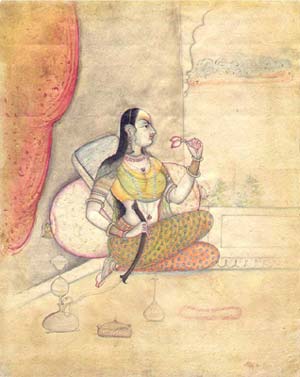
Thus by signifying the relation of the sensual to the spiritual, beauty to purity, and the physical to the divine, the potent metaphor of the lotus again emphasizes the inherent sacredness in women. 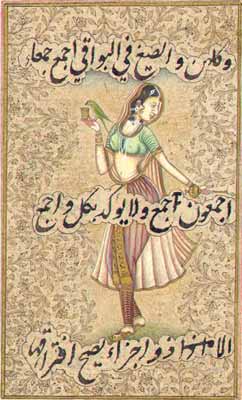
Woman Playing with a Parrot The parrot is the vehicle of the god of desire Kama, the impeller of creation. Kama is the god of beauty and youth. Creation is always preceded by desire, there can be no creation without desire. Indeed the symbol of the parrot is another pointer to the fundamental association of the feminine with the creative principle in nature.
ConclusionThus the Indian aesthetic tradition regards woman as an aspect of the Great Mother of all life, a vessel of fertility, and life in full sap. She embodies mystery through her fruitfulness. She is associated with nature and the earth. Indeed men in a number of primitive societies refuse to interfere with agriculture, believing it to be magically dependent on women. Because of her unique physiological experiences, like menstruation, defloration, conception, pregnancy, childbirth, and lactation, she is responsive to the mysterious periodicities connected with the phases of the moon, the cycles of the months, the seasons of the years and the rhythms of nature.
She lives separate existences as virgin, wife, mother, widow or spinster, each with its own experience and power. As a mother she is one of the great primordial archetypes of humanity. From her womb a new creature is born, at her breasts it is nourished, by her hands it is guided.
Indeed woman is superior to man in many ways. She has greater vitality; her resistance to disease, physical injury and major shocks is better than man's; girls, as a rule, are more precocious in their development than boys, and do not succumb so easily to illness. Women are more practical and down to earth, and some anthropologists think that rule by women preceded rule by men, and that the patriarchal system developed only when men settled down to a civilized life so as to leave women free to bring up the family.
Woman is the originator of families, the preserver of the established order and the perpetuator of traditions, which she imparts to her children. Through her the past is continued, not only in the physical life of her children, but in the respect for traditional heritage that she instills into them. As the Great Goddess rules the heavens, her earthly counterpart, the woman, rules the home.
It is the presence of women that lies at the source of most forms of totemism, exogamy, taboo, initiations, blood-rites, fertility rites and the mysteries. With women are associated the ideas of the unconscious, for some instinctive and intuitive process seems to put her in touch, through some secret sympathy, with the very heart of things.
She symbolizes the wisdom of the community, and the old woman and sage-femme is the keeper of the tribal lore and often the source of tribal strength. She is priestess, prophetess, sibyl, medium, oracle, pythoness, and witch. Skilled in herbs and balms she is the natural healer and nurse, first of her children, then of her hunter and warrior husband. Man penetrates into her interior, and deep within her body the child is created. She therefore stands for the innerness of things, the place where secret and hidden things happen. Indeed it is in her womb that the great magical transformation takes place that changes sperm into men.
Thus Manu, the first law-giver, said:
"The gods are satisfied wherever women are honored, but where they are not respected, rites and prayers are ineffectual."
(Manu Smriti 3.62)
References and Further Reading- Cooper, J.C. An Illustrated Encyclopedia of Traditional Symbols: London, 1999.
- Danielou, Alain. Virtue, Success, Pleasure, Liberation; The Four Aims of Life in the Tradition of Ancient India: Vermont, 1993.
- Dehejia, Vidya (ed.) Representing the Body (Gender Issues in Indian Art): New Delhi, 1999.
- Dehejia, Vidya (ed.). Devi The Great Goddess (Female Divinity in South Asian Art): Washington, 1999.
- Leslie, Julia. Roles and Rituals for Hindu Women: Delhi, 1992.
- Pal, Pratapaditya (ed). Dancing to the Flute (Music and Dance in Indian Art): Sydney, 1997.
- Tresidder, Jack. The Hutchinson Dictionary of Symbols: Oxford, 1997.
- Untracht, Oppi. Traditional Jewelry of India: London, 1997.
- Zimmer, Heinrich. Myths and Symbols in Indian Art and Civilization: Delhi, 1990.
- Zimmer, Heinrich. The Art of Indian Asia; Its Mythology and Transformation (two vols.): Delhi, 2001.
|
We hope you have enjoyed reading the article. Any comments or feedback that you may have will be greatly appreciated. Please send your feedback to feedback@exoticindia.com.
This article by Nitin Kumar http://www.exoticindia.com
|

















